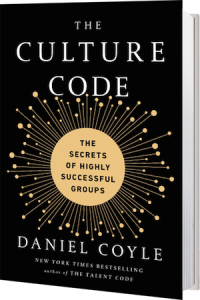 Think about a time when you were part of a team. It could be a sports team, a job setting, work with a volunteer organization – any group in which you were involved for a fairly long period of time.
Think about a time when you were part of a team. It could be a sports team, a job setting, work with a volunteer organization – any group in which you were involved for a fairly long period of time.
Now, look back and think about the group cohesiveness, the esprit de corps – or lack thereof. What emotions come to mind as you relive that experience?
I hope that you smiled and remembered positive experiences and results. But for many, functioning on a team means more meetings, more encounters with people’s egos, more wasting time.
That’s why I enthusiastically read Daniel Coyle’s new book, The Culture Code: The Secrets of Highly Successful Groups. His previous book, The Talent Code, remains one of my favorite reads, so I suspected this book would resonate as well.
Achieving a great team culture
 Coyle wrote The Culture Code to explore and explain how to create a great culture within your organization or team. But, he doesn’t stop there. He asks this important question: “How do you build and sustain it in your group, or strengthen a culture that needs fixing?”
Coyle wrote The Culture Code to explore and explain how to create a great culture within your organization or team. But, he doesn’t stop there. He asks this important question: “How do you build and sustain it in your group, or strengthen a culture that needs fixing?”
Coyle is a master story-teller and his points are amplified by stories about organizations as varied as the Navy Seals and the Upright Citizens Brigade – an improvisational group that helped launch Kate McKinnon and other recognized comedic actors.
What all these groups have in common is their laser-like commitment to imbue three critical skills among those involved:
- Build Safety
- Share Vulnerability
- Establish Purpose
The book is organized around these three skills. Coyle doesn’t just explain the skills, but he intersperses pithy stories about companies and organizations, most of which you will recognize.
The key message I am taking away from this book is that highly successful groups don’t happen by accident. They are masterfully shaped or reshaped by someone who understands that people are more important than programs and that building a close family-like relationship is essential.
Skill One: Build Safety
Those of you involved in our ABPC networks are probably not surprised to see psychological safety as one of the essential skills. During the 2017-18 school year, through our study of The Internal Coherence Framework (ICF), we’ve learned about the importance of psychological safety to teams of teachers and schools. In fact, both Coyle and the authors of the ICF reference research by Harvard Business School professor Amy Edmonson, who defines a psychologically safe environment as one “in which people speak up freely, unconstrained by the possibility of others’ disapproval or fear of negative consequences” (The Internal Coherence Framework, p. 40).

Coyle brings up “belonging cues,” which are certain behaviors that deepen connections so that people feel safe and part of a group. Belonging cues have three important qualities: (1) Energy: They invest in the exchange that is occurring; (2) Individualization: They treat the person as unique and valued; (3) Future orientation: They signal the relationship will continue. (p. 11).
Coyle brings psychological safety to life through stories about the emergence of Google as the premiere search engine, the Christmas Truce during World War I, a call center in India, and Tony Hsieh and Zappos shoes.
Skill Two: Share Vulnerability
Does this skill sound risky to you? Perhaps it is because your definition of vulnerability might not completely match Coyle’s. He calls on Dr. Jeff Polzer to explain that the skill of vulnerability is really about reciprocity:
It’s about sending a really clear signal that you have weaknesses, that you could use help. And if that behavior becomes a model for others, then you can set the insecurities aside and get to work, start to trust each other and help each other. (p. 104)
Like the first skill, Coyle tells stories of a variety of organizations that exemplify the sharing of vulnerability. The story I found most riveting was the description of a United Airlines Flight that lost its tail engine—one of three engines on the plane. The pilot, with help, managed to crash land the plane, saving 185 of the 285 people on board.

To understand how remarkable his actions were, consider that during countless simulations of the same scenario after the event, not one pilot was able to successfully land the plane.
Why? Investigators concluded that because the lead pilot almost immediately showed his vulnerability, he was able to quickly establish a helping culture. Rather than trying to “fix it” himself or bark orders to others, he asked the cockpit crew if they had any ideas. A pilot trainer, who happened to be onboard, also offered his support. Instead of taking over, the trainer said, “Tell me what you want, and I’ll help you.”
Instead of asserting ego and superior knowledge, this makshift team made themselves vulnerable and saved 185 lives.
Skill Three: Establish Purpose
Coyle writes: “when I visited…successful groups, I noticed that whenever they communicated anything about their purpose or their values, they were as subtle as a punch in the nose” (p 178). In other words, he found that effectively establishing purpose is much bigger than crafting and posting a mission statement. It’s about being consistent and modeling and reinforcing mission throughout the work.
The story that illustrated this third skill best (for me) reckoned back to the 1982 Tylenol poisoning incident. You may recall that, in Chicago, seven people died after consuming Extra-Strength Tylenol that had been tampered with and contained cyanide.
The CEO of Johnson & Johnson flew to D.C. to meet with the Food and Drug Administration and the FBI. Both organizations urged CEO James Burke just to recall Tylenol from the Chicago area, the epicenter of the poisoning. Like others in the industry, the federal officials understood that a massive recall could destroy Johnson and Johnson financially.
Instead, Burke recalled every Tylenol product on the market, more than 31 million pills. This action cost Johnson and Johnson $100 million (p. 175-176). Their stock declined and many thought it was the end of a storied company.
Why did Burke make this decision? He harkened back to Johnson and Johnson’s Credo, written back in 1943 by Robert Wood Johnson. The first two sentences read:
We believe our first responsibility is to doctors, nurses, and patients; to mothers and fathers and all others who use our products and services.
Burke believed that his actions were necessary to abide by the Credo. The named constituents in the Credo – and Johnson and Johnson employees – were his first concern. If he didn’t abide by the Credo, then what good was it? What better example of keeping mission and values first and foremost could there be?
Read the Book for Much More!
As I write this sentence, I realize that I’ve just covered the tip of a very deep iceberg. The book is full of insights, advice, and valuable stories, and is worth the time to read. But, don’t stop there, visit Coyle’s great website full of resources for The Culture Code: http://danielcoyle.com/
Perhaps after considering and acting on these proven strategies to strengthen your culture, you’ll smile when next asked to think back about your experience as a member of a team or organization.

0 Comments on "How to Create a Great Culture Within Your Organization or Team"